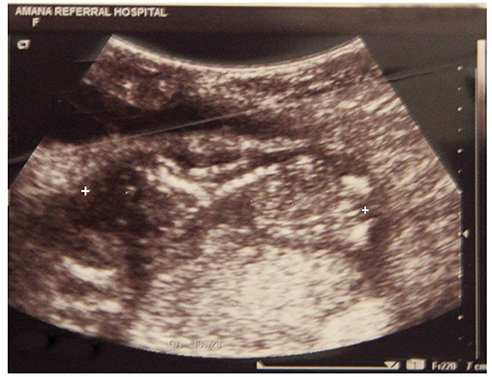Obstet Gynecol Sci.
2016 Nov;59(6):535-538. 10.5468/ogs.2016.59.6.535.
Secondary abdominal pregnancy in human immunodeficiency virus-positive woman
- Affiliations
-
- 1Korea International Cooperation Agency Tanzania Office, Dar es Salaam, Tanzania. elansingmi@gmail.com
- 2Department of Diagnostic Radiology and Medical Imaging, Muhimbili National Hospital, Dar es Salaam, Tanzania.
- KMID: 2378580
- DOI: http://doi.org/10.5468/ogs.2016.59.6.535
Abstract
- We report on an abdominal pregnancy in human immunodeficiency virus-positive mother, currently on antiretroviral therapy, which was discovered incidentally while training the obstetric ultrasound capacity building program. Although abdominal pregnancy is a rare form of ectopic pregnancy, it may be more common in women with HIV infection because they tend to have a higher rate of sexually transmitted diseases than the general population. The positive diagnosis of abdominal pregnancy is difficult to establish and is usually missed during prenatal assessment particularly in settings that lack routine ultrasound examination as is the case in most developing countries. For the management of abdominal pregnancy, surgical intervention is recommended and removal of the placenta is a key controversy. Ultrasonography is considered the front-line and most effective imaging method and an awareness with a high index of suspicion of abdominal pregnancy is vital for reducing associated high maternal and even higher perinatal mortality.
MeSH Terms
Figure
Reference
-
1. Kun KY, Wong PY, Ho MW, Tai CM, Ng TK. Abdominal pregnancy presenting as a missed abortion at 16 weeks’ gestation. Hong Kong Med J. 2000; 6:425–427.2. Scheiber MD, Cedars MI. Successful non-surgical management of a heterotopic abdominal pregnancy following embryo transfer with cryopreserved-thawed embryos. Hum Reprod. 1999; 14:1375–1377.3. Audain L, Brown WE, Smith DM, Clark JF. Cocaine use as a risk factor for abdominal pregnancy. J Natl Med Assoc. 1998; 90:277–283.4. Yildizhan R, Kolusari A, Adali F, Adali E, Kurdoglu M, Ozgokce C, et al. Primary abdominal ectopic pregnancy: a case report. Cases J. 2009; 2:8485.5. Dahab AA, Aburass R, Shawkat W, Babgi R, Essa O, Mujallid RH. Full-term extrauterine abdominal pregnancy: a case report. J Med Case Rep. 2011; 5:531.6. Studdiford WE. Primary peritoneal pregnancy. Am J Obstet Gynecol. 1942; 44:487–491.7. Rahman MS, Al-Suleiman SA, Rahman J, Al-Sibai MH. Advanced abdominal pregnancy: observations in 10 cases. Obstet Gynecol. 1982; 59:366–372.8. Porwal S, Gupta R. Secondary abdominal pregnancy following tubal abortion: a unique case. J Pharm Biomed Sci. 2012; [Epub]. http://www.jpbms.info/index.php?option=com_docman&task=doc_view&gid=409&t mpl=component&format=raw&Itemid=41.9. Allibone GW, Fagan CJ, Porter SC. The sonographic features of intra-abdominal pregnancy. J Clin Ultrasound. 1981; 9:383–387.
- Full Text Links
- Actions
-
Cited
- CITED
-
- Close
- Share
- Similar articles
-
- Four Cases of Human Immunodeficiency Virus-infected Mothers in Pregnancy
- A Case of Ankylosing Spondylitis in a Patient with Human Immunodeficiency Virus
- Anesthetic Management of Cesarean Section in Human Immunodeficiency Virus (HIV)Positive Pregnant Woman : A case report
- Successive Term Delivery in Women with Stable Human Immunodeficiency Virus Infection: A Case Report
- A Case of Human Immunodeficiency Virus -triggered Hemophagocytic Lymphohistocytosis Presenting with Severe Bleeding Tendency



